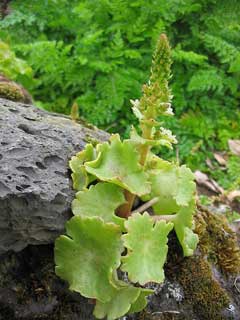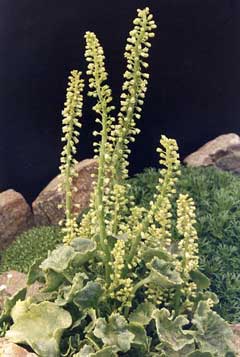 |
|
commons.wikimedia.org/wiki/User:Ixitixel |
 |
| commons.wikimedia.org/wiki/User:Ghislain118 |
Translate this page:
Summary
Physical Characteristics

 Umbilicus rupestris is an evergreen Perennial growing to 0.3 m (1ft).
Umbilicus rupestris is an evergreen Perennial growing to 0.3 m (1ft).
See above for USDA hardiness. It is hardy to UK zone 7 and is not frost tender. It is in leaf all year, in flower from June to August, and the seeds ripen from July to September. The species is hermaphrodite (has both male and female organs) and is pollinated by Insects? Self. The plant is self-fertile.
Suitable for: light (sandy) and medium (loamy) soils and prefers well-drained soil. Suitable pH: mildly acid, neutral and basic (mildly alkaline) soils. It can grow in semi-shade (light woodland) or no shade. It prefers moist soil.
UK Hardiness Map
US Hardiness Map
Synonyms
U. pedulinus. Cotyledon umbilicus-veneris.
Plant Habitats
Cultivated Beds; North Wall. In. East Wall. In. South Wall. In. West Wall. In.
Edible Uses
Edible Parts: Leaves
Edible Uses:
Leaves - raw or cooked[2, 105, K]. A very acceptable mild flavour in the winter and early spring, they can be used in quantity in salads at this time[K]. The leaves become rather stronger-tasting in the summer and are not so pleasant then[K].
References More on Edible Uses
Medicinal Uses
Plants For A Future can not take any responsibility for any adverse effects from the use of plants. Always seek advice from a professional before using a plant medicinally.
Analgesic Diuretic Epilepsy Poultice
The leaves are mildly analgesic[7]. The juice and extract of the plant have an old reputation for the treatment of epilepsy[4]. The leaves are also made into a poultice and used in the treatment of piles, slight burns and scalds[4, 7]. A decoction of the leaves is considered to be cooling and diuretic and the juice taken inwardly is said to be excellent for treating inflammations of the liver and spleen[4].
References More on Medicinal Uses
The Bookshop: Edible Plant Books
Our Latest books on Perennial Plants For Food Forests and Permaculture Gardens in paperback or digital formats.

Edible Tropical Plants
Food Forest Plants for Hotter Conditions: 250+ Plants For Tropical Food Forests & Permaculture Gardens.
More

Edible Temperate Plants
Plants for Your Food Forest: 500 Plants for Temperate Food Forests & Permaculture Gardens.
More

More Books
PFAF have eight books available in paperback and digital formats. Browse the shop for more information.
Shop Now
Other Uses
References More on Other Uses
Cultivation details
An easily grown plant, succeeding in any near neutral, gritty, moisture retentive but well-drained soil in sun or light shade[200]. Plants are often found growing on walls, even succeeding on old brick and mortar walls[K] Plants are hardy to about -15°c[200]. A very attractive plant for the rock garden[53], the leaves often stay green all winter[4].
References Carbon Farming Information and Carbon Sequestration Information
Temperature Converter
Type a value in the Celsius field to convert the value to Fahrenheit:
Fahrenheit:
The PFAF Bookshop
Plants For A Future have a number of books available in paperback and digital form. Book titles include Edible Plants, Edible Perennials, Edible Trees,Edible Shrubs, Woodland Gardening, and Temperate Food Forest Plants. Our new book is Food Forest Plants For Hotter Conditions (Tropical and Sub-Tropical).
Shop Now
Plant Propagation
Seed - sow spring in a cold frame and only just cover the seed. When they are large enough to handle, prick the seedlings out into individual pots and plant them out in early summer. Division in spring. Very easy, pant them straight out into their permanent positions. Leaf cuttings[200].
Other Names
If available other names are mentioned here
Native Range
TEMPERATE ASIA: Cyprus, Egypt (Sinai), Lebanon, Turkey EUROPE: United Kingdom, Ireland, Albania, Bulgaria, Bosnia and Herzegovina, Greece (incl. Crete), Croatia, Italy (incl. Sardinia, Sicily), North Macedonia, Slovenia, Spain (incl. Baleares), France (incl. Corsica), Portugal AFRICA: Portugal (Madeira Islands), Algeria, Libya, Morocco, Tunisia
Weed Potential
Right plant wrong place. We are currently updating this section.
Please note that a plant may be invasive in one area but may not in your area so it's worth checking.
Conservation Status
IUCN Red List of Threatened Plants Status :

Growth: S = slow M = medium F = fast. Soil: L = light (sandy) M = medium H = heavy (clay). pH: A = acid N = neutral B = basic (alkaline). Shade: F = full shade S = semi-shade N = no shade. Moisture: D = dry M = Moist We = wet Wa = water.
Now available:
Food Forest Plants for Mediterranean Conditions
350+ Perennial Plants For Mediterranean and Drier Food Forests and Permaculture Gardens.
[Paperback and eBook]
This is the third in Plants For A Future's series of plant guides for food forests tailored to
specific climate zones. Following volumes on temperate and tropical ecosystems, this book focuses
on species suited to Mediterranean conditions—regions with hot, dry summers and cool, wet winters,
often facing the added challenge of climate change.
Read More
Expert comment
Author
(Salisb.)Dandy.
Botanical References
17200
Links / References
For a list of references used on this page please go here
Readers comment
© 2010, Plants For A Future. Plants For A Future is a charitable company limited by guarantee, registered in England and Wales. Charity No. 1057719, Company No. 3204567.